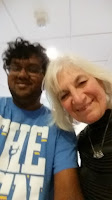Art, Technology, and the Medical Field
Art and Technology in the Medical Field (Person using the Spirometer) One example of medical technology and art is in something called spirometry. Spirometry is used test how strong your lungs are by measuring how much you inhale, exhale, and how fast you exhale (Mayo Clinic Staff). As someone who has asthma, when I visit my pediatrician back home I she makes me use this machine. How this works is that, while blowing,there is an animation on the screen to see your progress. It shows a tree covered with leaves, but as you blow the leaves away, you can see animals in the tree. After this, it shows a graph to the nurse monitoring the activity and states whether it was a good test or it needs to be done again. Usually with me, I do it about 7 to 10 times. Strangely, this actually makes the asthma a little worse and I clear my throat a lot more. Interesting how they use an animation with this machine so one can see their progress based off of how many animals they can see. ...
